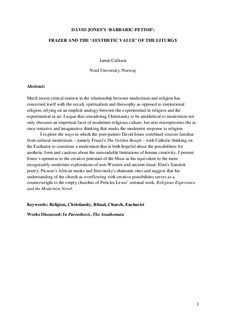David Jones’s ‘Barbaric-fetish’ : Frazer and the ‘Aesthetic Value’ of the Liturgy
Journal article, Peer reviewed
Accepted version
Permanent lenke
http://hdl.handle.net/11250/2486340Utgivelsesdato
2017Metadata
Vis full innførselSamlinger
Originalversjon
Callison, J. C. (2017). David Jones’s ‘Barbaric-fetish’: Frazer and the ‘Aesthetic Value’ of the Liturgy. Modernist Cultures, 12(3), 439-462. doi: 10.3366/mod.2017.0186Sammendrag
Much recent critical interest in the relationship between modernism and religion has concerned itself with the occult, spiritualism, and theosophy as opposed to institutional religion, relying on an implicit analogy between the experimental in religion and the experimental in art. I argue that considering Christianity to be antithetical to modernism not only obscures an important facet of modernist religious culture, but also misrepresents the at-once tentative and imaginative thinking that marks the modernist response to religion. I explore the ways in which the poet-painter David Jones combined sources familiar from cultural modernism – namely Frazer's The Golden Bough – with Catholic thinking on the Eucharist to constitute a modernism that is both hopeful about the possibilities for aesthetic form and cautious about the unavoidable limitations of human creativity. I present Jones's openness to the creative potential of the Mass as his equivalent to the more recognisably modernist explorations of non-Western and ancient ritual: Eliot's Sanskrit poetry, Picasso's African masks, and Stravinsky's shamanic rites and suggest that his understanding of the church as overflowing with creative possibilities serves as a counterweight to the empty churches of Pericles Lewis’ seminal work, Religious Experience and the Modernist Novel.
